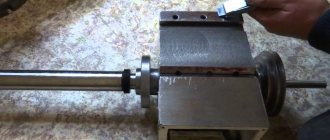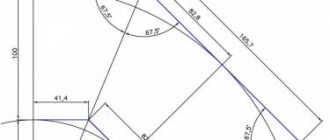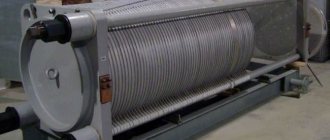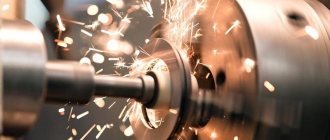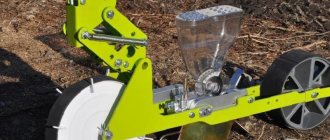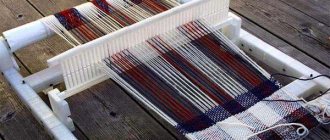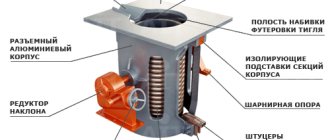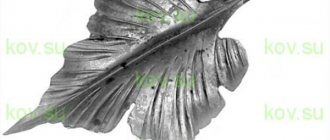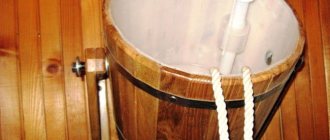→ Fittings
Scrapers.
Manufactured from tool carbon steel grades U10, U12. The cutting end of the scraper is hardened without tempering to a hardness of HRC = 60-65.
According to the shape of the working surface, scrapers are divided into flat, triangular, and shaped; by the number of cutting ends - single-sided and double-sided, by design - solid and with insert plates.
Single-sided scrapers
, like files, are equipped with handles;
double-sided
handles.
Flat scrapers
(Fig. 159, a) used for processing straight surfaces; scraper with a curved end (Fig. 159, b) - for scraping in sharp corners or for scraping soft metals, such as aluminum, zinc, babbitt, etc. Double-sided flat scraper (Fig. 159, c), made of round steel, thanks to Having two ends has a longer service life.
The length of flat one-sided scrapers is 100-250 mm, and double-sided ones 350-400 mm. The width of the scraper for coarse scraping is taken from 20 to 30 mm, for fine scraping - 16-20 mm and for the most precise - 5-10 mm. The thickness of the end of the cutting part ranges from 1 to 3.5 mm. The sharpening angle of the scrapers is 60-75° for rough scraping, and 90° for finishing scraping.
Triangular scrapers
(Fig. 159, d) are used for scraping concave and cylindrical surfaces. As a rule, they are produced only one-sided. Often triangular scrapers are made from worn triangular personal files.
According to the shape of the cutting ends, scrapers are divided into straight and curved.
To facilitate sharpening of the planes, the scraper has grooves that form cutting edges with a sharpening angle of 60°.
The length of triangular scrapers is 75-100 mm.
Rice. 159. Designs of scrapers and sharpening angles
:
a - flat one-sided, b - with a curved end, c - flat double-sided, d - triangular
Shaped scrapers
used for scraping hard-to-reach places (bottom of depressions, closed contours, grooves, grooves and other shaped surfaces). These scrapers are a set of steel plates 1-2 mm thick mounted on a handle. The end faces of the plates are sharpened to the appropriate shape.
Composite scrapers
shown in Fig. 160. In order to avoid frequent sharpening of cutting edges, many factories use scrapers that allow the installation and replacement of plates of various sizes.
In Fig. 160, and is given a universal scraper, consisting of a body 3, a holder 2, a handle 5, a clamping screw 4, a replaceable cutting plate 1 made of tool high-speed steel or hard alloy.
The plate inserted into the holder is clamped with a screw by rotating the scraper handle clockwise, and when removing the plate, the handle is rotated counterclockwise.
Rice. 160. Composite scrapers
:
a - universal scraper: 1 - plate, 2 - holder, 3 - body, 4-clamping screw, 5 - handle; b - scraper designed by S. G. Kononenko; c - scraper with replaceable blades: 1 - replaceable blades, 2 - clamping chuck, 3 - rod; d - composite scrapers, d - scraper designed by V. A. Alekseev with radius sharpening
The innovator S. G. Kononenko invented a more advanced scraper design, which consists of three parts: a holder, a wooden handle and a replaceable plate (Fig. 160, b). The replacement insert has a dovetail shank and the holder has a groove that matches the insert. The replacement plate is installed in the groove of the holder, which ensures a reliable connection and quick change of plates. The records are sharpened in tool shops.
In Fig. 160, c shows the most advanced scraper, consisting of a replaceable plate 1, a clamping chuck 2 and a rod 3. The scraper plates are made of size 3X16x50 from tool carbon steel U12A, and the rod is made of carbon steel 45. Replacing a blunt plate is done by turning the handle (rod), since the jaw of the clamping part of the cartridge is hingedly connected to the body.
This design of the scraper allows the use of a set of plates sharpened at different angles.
Innovative mechanics of Uralmashplant
proposed to replace heavy solid forged scrapers with composite ones. In these scrapers (Fig. 160, d), the cutting blades are made of thin plates (twice as thin as usual), which significantly speeds up their sharpening and finishing. The plates are inserted or soldered to a hollow tube. Such scrapers spring during operation, and this increases the sensitivity of the scraper’s hands and contributes to the accuracy of scraping.
The design of the scraper with radius sharpening, proposed by the innovative mechanic of the Saratov Bearing Plant V. A. Alekseev (Fig. 160, e), is original in design. Alekseev's scraper, thanks to its smoothness and ease of penetration into the scraped part, facilitates work and helps to increase labor productivity.
You can clean metal surfaces of old paint and rust. You can also use a scraper to adjust two mating surfaces; for example, guides are usually scraped on a lathe. All parts used in the homemade product are made from old car parts.
In order to make a scraper from a steering rod with your own hands, you will need:
* Old tie rod from a car * Angle grinder, cutting disc * Personal protective equipment, gloves, headphones, safety glasses * Electric drill, metal drill with a diameter of 5 mm * M6 tap * M6 threaded bolt * Bench vice * File * Steering end * Spray can hammer paint * Valve clearance adjusting washer
Step one.
First you need to free the steering rod from the hinge. We install it in a bench vice and, using an angle grinder with a cutting wheel installed, saw off the hinge, being careful not to damage the ball on the rod. When working with an angle grinder, be careful and wear safety glasses, ear protection and gloves.
Step two.
To fix the scraper plate, which will also need to be made, it is necessary to cut off the excess part from the steering tip using an angle grinder.
Next, mark a line in the middle at the end of the sawn piece. Then we clamp it in a vice and begin to make a cut with a thickness of 4 mm, which is equal to the thickness of the washer; for this we install three cutting discs in the angle grinder. After the cut is ready, we try on the washer; it should fit tightly into it. If necessary, trim the groove using a file. In order to be able to clamp the washer into the part, we cut another groove, but deeper. In the end it should look like this. Step three.
We make a mark for drilling a hole in the workpiece.
Then we fix the workpiece in a vice. We drill a through hole using an electric drill with a 5 mm metal drill installed in its chuck. After this, we cut the thread using an M6 tap. During the threading process, lubricate the cutting edge of the tool with technical oil, so it will last longer. We check how the bolt is screwed in by hand. Step four.
Now for the scraper you need to make a scraper plate. We make it from a valve clearance adjustment washer, first apply the markings with a marker, and then use an angle grinder to saw off the excess parts. After manipulations with an angle grinder, the following plate was obtained. The working edge was slightly rounded. Finally, we paint the steering rod handle with a can of hammer paint.
Step five.
We install the plate in its place, then fix it with a bolt using a hexagon.
And, by the way, after I bought kosher records from VK6OM, I realized that it is impossible to make a scraper from a file. From a file you can make a quickly dulling, scuffing, picking kind of scraper. Which file is suitable?
Not every file will do, I went through four from the stock, and only one worked.
It should be made of a suitable metal that will not become dull after the first cut, like the metal of a chisel, for example. And the file should also have a comfortable handle with a round end so that it does not stick into the palm. The surface class is checked by the number of touch spots in a 25 mm square. Let's say you need 15 spots. This means that one spot should be about 6 mm in diameter (I calculated by area). It is quite possible to cut it with a scraper 8-10 mm wide. This means you need to choose a file of this width. For rough processing you can go wider. The length of the file should be two to four centimeters larger than the width of the palm, if you work “from yourself”. But if you work “for yourself,” then you need to be much longer; the handle should rest on your shoulder when the cutting edge touches the workpiece. And you didn’t have to bend over to do it. How to sharpen a file into a scraper.
If you need to remove a large allowance, then it is better to make a scraper with a straight cutting edge; for finishing scraping, you need to make a scraper with a round cutting edge.
The cleaner the scraping, the smaller the edge radius. First of all, the file needs to be sharpened like a scraper. Using electric sandpaper, in very short sessions, so that the metal does not have time to let go - just rub it a little and immediately into the water. You can do it on a block, but it will take longer, but it won’t let go for sure. The task is to cut off a notch of 10 millimeters from the very end on one side, make the end more or less flat, and make curves on the sides with a radius of a millimeter. For rough scraping, the scraper can already be used, but for finishing scraping it still needs to be refilled. To do this, you need an F120 abrasive stone or smaller, with a flat surface (the new ones have a fairly flat surface, but the old one, guess what, you can rub it against something iron to achieve the same effect). It is convenient to secure the block on some kind of board or directly on the table so that it does not move around. I tried to fill the edge with diamond paste 40-28 and 7-5 on a duralumin plate (they say you need cast iron, but I don’t have it). He sharpened in the direction opposite to the one in which to cut. It may not be correct, but it won’t sharpen otherwise. First, place the scraper on the block with the place from which the notch was cut, and move it towards the handle several times so that this surface becomes flat. Press the end with your left hand, pull the handle with your right. After this treatment, a little metal will stretch out on the cutting surface, but this is not a big deal. Then you need to place the scraper with its end on the block and, holding with both hands as close to the cutting edge as possible, grind off the hole and other irregularities from the emery disk. If the cutting edge comes out slightly not perpendicular to the sides of the file, it’s not a big deal. For cast iron, the angle between these turned surfaces should be 90-100 degrees. It must be maintained when processing the end surface. Hold the cutting edge obliquely relative to the direction of movement, then it turns out straight. Or maybe just a little convex. Finally, the rounded sides need to be blunted so they don't leave deep holes. During operation, the file scraper has to be refilled very often. Dull, it begins to jump or crush, resulting in transverse stripes on the cut. And if it becomes unevenly dull, it begins to leave longitudinal scratches. Or it stops “grabbing” the metal altogether and slides along the surface. It is enough to simply correct the end surface, as I have already described. How to scrape “on your own.”
With your left hand, hold the file itself in your fist. Right - by the handle. Aim more with your left hand, push more with your right. I saw that the scraper handle is held between the index and middle fingers of the right hand, like a cuckoo. It seemed so uncomfortable to me, I clamp the index finger of my right hand with my left hand along with the file, it’s more convenient to aim, it’s like scraping with your index finger, you definitely won’t miss.
Later
To fill the scraper, you need to take even finer abrasive, twice as much. Although the file metal does not leave such terrible grooves. But if you process a carbide plate with 125 diamond, then for some reason the marks on the metal remain noticeable.
Quite later.
Here is a sketch of a thing to manually thread a scraper plate. Yes, and a file can do that, probably.
The scraper tool is used to process friction surfaces with low roughness to obtain an accurate shape and size and ensure maximum fit and tightness of the connection. As a rule, a scraper cuts small chips on a surface that has been previously processed with other cutting tools.
§ 4. Scraping straight surfaces
Paints for scraping .
After preparing the surface for scraping, unevenness is identified by painting the surface with paint. Scraper paint is a mixture of machine oil with glaze and, less commonly, red lead and ultramarine (blue), which, unlike glaze, do not mix well with oil and are not clearly visible on the part. Azure can be replaced with soot mixed with a mixture of autol and kerosene.
The paint is crushed so that no grains are felt between the fingers. Then the paint is poured into a jar (metal or glass) and oil is poured into it. The amount of machine oil in the mixture should be such that the paint has the consistency of a paste, but not liquid, since excess oil will spread over the control plate and the surface to be tested, when applied to the plate, will be completely covered with paint.
Surface painting . The paint is applied to the surface of the slab with a swab (Fig. 229) of clean linen rags folded in several layers. It is also convenient to apply paint with a bag made of clean linen (canvas), into which the paint is applied.
Rice. 229. Painting the surface when scraping: a - painting the slab, b - moving the part along the slab, c - the painted part, d - moving the slab along the fly, e - tampons
During pauses between stainings, the bag and swabs are placed in a clean glass container or tin jar. Under no circumstances should you put dry paint in a bag and dip it in oil.
Before painting, remove shavings and dirt from the surface of the part with a hair brush or a clean rag, carefully place the part with the surface to be treated on the surface of the slab and move it slowly. To achieve uniform wear of the plate, it is necessary to use its entire surface.
After two or three circular movements on the plate, the part is carefully removed. On well-treated surfaces the paint applies evenly over the entire surface, on poorly prepared surfaces it applies unevenly. In small recesses the paint will accumulate, but in deeper places there will be no paint at all. This is how white spots appear - the deepest places not covered with paint; dark spots are less deep, paint has accumulated in them; gray spots are the most prominent; paint is applied to them in a thin layer.
When determining irregularities on the surfaces of heavy parts that cannot be removed from their place, a painted testing tool—a plate or a ruler—is moved along the controlled surfaces.
When scraping, light parts (products) are mounted on a bench, and large and heavy ones are mounted on trestles.
The scraping process involves gradually removing metal from painted areas (gray spots). The scraper is held by the handle with the right hand, and the end of the scraper is pressed with the left hand (Fig. 230, a). In relation to the surface being processed, the scraper is installed at an angle of 25-30°, and the cutting angle is obtuse (30°+90°= 120°). The metal is removed by scraping. The working stroke when scraping is a forward movement, i.e. away from you, and when working with a flat scraper with the end bent down, it is a backward movement, i.e. towards yourself. When moving backwards (idling), the scraper is raised.
Rice. 230. Scraping techniques: a - “from yourself”, b and c - “from yourself”, d - fine scraping
The method of scraping “on your own” has the following disadvantages:
- The scraper is not stable enough during the working stroke, as a result of which the chips are not uniform in cross-section, the surface is uneven and torn;
- At the end of each movement, the scraper leaves burrs that have to be removed additionally.
The scraper designed by A. A. Baryshnikov differs from the usual ones in its greater length (up to 500 mm), which allows scraping to be carried out using a “pull” technique.
When working with this technique, the scraper is grasped by the middle part with both hands and placed to the surface to be treated not at an angle of 30°, as is done when scraping with a push-pull technique, but at an angle of 75-80° (Fig. 230, b). The upper end of the scraper, which has a wooden handle, rests on the worker’s shoulder.
The advantages of this scraping technique:
- the increased length of the scraper allows you to use, in addition to the hands, also the shoulder of the worker, the scraper turns out to be more stable. In addition, a long scraper is springy, so its cutting part cuts into the metal and comes out of the metal smoothly: the surface is more even, without flaws, and at the end of the stroke there are no burrs;
- The technique of scraping “on oneself” is 1.5-2 times more productive than the method of scraping “from oneself.”
To obtain a high-quality surface, rough, semi-finish and fine scraping are performed sequentially.
Rough scraping (preliminary) consists of rough surface treatment: traces and risks of previous processing are removed. The work is carried out with a scraper 20-30 mm wide with a working stroke length of 10-15 mm. The direction of the scraper is continuously changed so that the next stroke is at an angle of 90° to the previous one.
In one stroke of the scraper, chips with a thickness of 0.02-0.05 mm are removed. Scrub until visible risks disappear. The quality of scraping is checked by the paint, which is applied to the surface plate. After applying and moving (slabs or parts), the detected protruding areas are scraped again.
Radiant scraping (spot scraping) consists of removing only the gray, i.e., most protruding places identified by a paint test. The work is carried out with a flat narrow (12-15 mm) scraper with a working stroke length of 5 to 10 mm; in one stroke of the scraper, chips with a thickness of 0.01-0.02 mm are removed.
Finish scraping (finishing) is used to obtain very high surface accuracy. With light pressure on the scraper, thin (8-10 microns) chips are removed. Scrapers with a width of 8 to 10 mm are used (Fig. 230, d) with a working stroke length of 4-5 mm (small strokes).
Precision scraping and quality control . By scraping you can obtain high accuracy (0.003-0.01 mm) and cleanliness of processing.
The quality of scraping is determined by the number of spots (points) per unit of treated surface. The larger this number, the higher the accuracy of the machined surface. To determine the degree of accuracy, use a square frame of 25x25 mm (Fig. 231), which is placed on a scraped surface and the number of spots in it is determined.
Rice. 231. Quality control of scraping with a testing frame
Scraping is completed with the following numbers of spots on the surface, limited by a frame of 26x25 mm: rough 4-6, semi-finish 8-16, finishing 20-25.
For example, scraping is completed when scraping with a test frame the following numbers of spots: parts of metal-cutting machines (beds, tables, carriages, supports, etc.) 8-16, calibration plates and rulers 20-25, tools and measuring instruments 25-30.
Areas of application for scrapers
Using a scraper, a specialist removes the thinnest layer of metal from the workpiece, the thickness of which can vary between 0.005–0.7 mm, which allows the degree of surface roughness to be brought to the required level. With the help of such a technological operation, parts are often processed that will subsequently mate and move relative to each other. The most common parts for finishing which various types of scrapers are used are:
- parts of machine tools and high-precision instruments;
- elements of sliding bearings;
- various measuring instruments and devices for carrying out control operations;
- blades of cutting tools (to sharpen them, a so-called sharpener-scraper is used).
Scraping - finishing the lathe slide guides
One of the advantages of scrapers is their versatility, so their scope of application is not limited to the above points. Using such tools, they perform engraving work on the surface of soft materials, process the edges of parts, and remove old coating. They have also found application in cosmetology; manicurists use them to perform their manipulations.
The scrapers used to solve various problems can be distinguished from each other even by photos, since they have different designs and geometric parameters. Thus, a miniature manicure tool is made in the form of a spatula with a comfortable handle, and devices for scraping large workpieces can be produced in the form of carbide plates. It is quite difficult for a non-specialist to guess that such a plate is a scraper, even if he sees it in person and not in a photo. To use this tool, you need a special lock, equipped with a comfortable handle for performing metalwork manipulations.
The scraping technology depends both on the size and configuration of the workpiece, and on the hardness of the material from which it is made. A specialist who is going to perform such a technological operation must correctly select the sharpening angle of the working end part of the scraper relative to its axis. When processing different materials, this angle must be within the following limits:
- when scraping soft metals – 35–400;
- when processing the surfaces of steel parts – 75–900;
- when performing scraping of parts made of cast iron and bronze - more than 900.
§ 76. Basic scraping techniques
Before scraping, the surfaces are cleaned, washed, wiped, and then paint is applied to them.
Paints for scraping. After cleaning the workpiece before scraping, unevenness is identified by painting the surfaces with paint. Scratch paint is a mixture of machine oil with glaze and (also with red lead and ultramarine (blue), which, unlike glaze, do not mix well with oil and are not clearly visible on the part. The glaze can be replaced with soot mixed with a mixture of autosol and kerosene.
Rice. 321. Painting flat surfaces when scraping: a - painting the slab, b - moving the part along the slab (painting), c - painted part, with a swab, d - moving the slab over the part
The paint is crushed so that no grains are felt between the fingers. Then the paint is poured into a jar (metal or glass) and oil is poured into it. The amount of machine oil in the mixture should be such that the paint has the consistency of a paste, but not liquid, since excess oil will spread over the control plate and the surface to be tested, when applied to the plate, will be completely covered with paint.
Surface painting
. The paint is applied to the surface of the slab with a swab (Fig. 321, a) of clean linen rags folded in several layers. It is also convenient to apply paint with a bag made of clean linen (canvas), into which the paint is applied.
During pauses between stainings, the bag and swabs are placed in a clean glass container or tin jar. Under no circumstances should you put dry paint in a bag and dip it in oil.
Before painting, remove shavings and dirt from the surface of the part with a hair brush or a clean rag, carefully place the part with the surface to be treated on the surface of the slab and move it slowly. To achieve uniform wear of the plate, it is necessary to use its entire surface.
After two or three circular movements on the plate (Fig. 321, b), the part is carefully removed. On well-treated surfaces, the paint spreads evenly over the entire surface (Fig. 321, c), on poorly prepared surfaces - unevenly. In small recesses the paint will accumulate, but in deeper places there will be no paint at all. This is how white spots appear - the deepest places not covered with paint; dark spots are less deep, paint has accumulated in them; gray spots are the most prominent; paint is applied to them in a thin layer.
Rice. 322. Techniques for scraping flat parts: a - 'from yourself', b - 'but from yourself'
When determining irregularities on the surfaces of heavy parts that cannot be removed from their place, a painted calibration tool - a plate (Fig. 321, d) or a ruler - is moved along the controlled surfaces.
When scraping, light parts (products) are mounted on a bench, and large and heavy ones are mounted on trestles.
The scraping process involves gradually removing metal from painted areas (gray spots). The scraper is held by the handle with the right hand, and the end of the scraper is pressed with the left hand (Fig. 322, a). In relation to the surface being processed, the scraper is installed at an angle of 25 - 30°, and the cutting edge should be on the painted surface. The metal is removed by scraping. The working stroke when scraping is a forward movement, i.e. “pull away”, and when working with a flat scraper with the end bent down, it is a backward movement, i.e. “pullwards”. When moving backwards (idling), the scraper is raised.
Types of tools for scraping
Today, specialists use various types of scrapers, differing from each other in several parameters. One of these parameters is the shape of the cutting part of the tool, depending on which scrapers are divided into flat, triangular and shaped. Unlike flat and triangular type tools, shaped scrapers have a working part that completely follows the shape of the surface of the workpiece.
Scrapers with various working parts
Triangular scraper with wooden handle
A tool, the working part of which has several edges, mainly processes cylindrical and concave surfaces, and flat scrapers successfully cope with the processing of various grooves and grooves. In practice, disc and ring-shaped scrapers are often used. With the help of the former, parts with wide surfaces are processed, and the latter are used for scraping products that have a round shape.
According to their design, scrapers can be one-piece or dismountable, single- or double-sided. More durable are double-sided scrapers, which differ from single-sided scrapers in that they have two working parts located on both sides of the handle.
Composite scraper device
The working part of the scraping tool, according to its location relative to the handle, can be flat or curved. Scrapers, the working part of which has a curved shape, are most conveniently used for processing soft metals, as well as parts with sharp corners.
Relatively recently, only hand scrapers were used in plumbing, but today many manufacturers offer tools equipped with a pneumatic or electric drive. You still have to manipulate such a tool manually, but this requires much less effort than when using a hand scraper.
Universal scraper BIAX
Comments • 67
Hello, the other day I tried different rulers for this matter. In general, I came across a knife from fur. guillotine 450mm. The cutting edge is as heavy as a Turkish saber, but the opposite side is nothing like a shell. We checked the plane on the milled pancake. The result is that the spruce paint is visible on one side 3mm, and so it’s ideal
You can buy it at a hardware store)
It is better to buy soot (fingerprint powder) in a store that sells consumables for forensics
Why not install glass and accumulate soot?
I will use soot from a gas heating boiler
Sorry, but having a Lathe “burns the wires.” ((((((((((((((I will refrain from epithets (((((((((((((((((
Hm. Well, tell us how to get soot from wires on a lathe without burning them!
Wires are another topic, but soot is a side effect.
Really paint the car
Try graphite lubricant
We have it (in common parlance - blue) with castor oil.
You need a banal candle and a piece of glass over the flame. You remove the soot and put it in a jar of oil.
@Korablev I agree completely.
And how much soot can you get this way? A couple of matchboxes? Soot can be found in abundance in any village house with stove heating, and in fair quantities. Half a liter, or even more, can be easily heated from one stove
I bought myself a Weiler Lz300w. The bed is worn out, so I look at your works. To be honest, it’s boring, I’m afraid of ruining it. But I'm determined to do everything with my own hands.
This is not soot, but coal! The soot is taken from the walls of the smoker or from the glass that is placed over the fire!
For scraping, it is used simply with soot, but with oil or gas, i.e. fine soot from combustion with a lack of oxygen. Mix with autosol until soft plasticine thickens and dilute with kerosene until it becomes sour cream (smooth). Prussian blue, a finely dispersed paint (precipitate from the merging of two solutions), is mixed with oil until it floats. Available in art salons, both in powder form and thickly grated with linseed oil. Price 20-100 rubles. Thickly ground Prussian blue should be slightly diluted with machine oil, and gas soot with kerosene (it is very sticky). For scraping, azure is more convenient. Soot is very capricious, you need to know how to work with it, but it gives higher accuracy (3 microns) than azure (5 microns). Almost all other paints are either crushed minerals and sifted through sieves (with water), or artificial sintered ones such as blue and also crushed with a particle size of up to 0.02 mm.
Choosing a metal scraper for scraping the metal surface
Metalwork related to the preparation of metal and wooden surfaces by removing irregularities is carried out using a special tool equipped with a cutting edge. Scraping, or grinding, contains different technologies for finishing workpieces for parts; the operation is carried out both directly with devices and with the use of abrasives of different grain sizes. All working processes allow you to obtain a workpiece with a perfectly smooth surface; scrapers for metal and wood help create tight adhesion to other parts.
What is a scraper?
A tool designed to remove a thin layer of metal from the surface of a workpiece, used to remove the surface film before soldering or welding elements of a loaded structure, as well as before assembling parts of precision instruments. Using the scraping method, the sharp edge of a metal scraper blade removes the top layer of material 0.01 mm thick.
Metal scraping is also used when sanding wood after processing with other tools. During the cleaning process, the surface is checked with a surface plate covered with a layer of paint. The presence of irregularities is revealed by painting individual sections of the workpiece, which are removed by repeated scraping of the problem area.
Metalwork scrapers differ:
- A shape that can be flat, shaped, multifaceted
- A design that contains replaceable plates
- Number of grinding edges: one-sided, two-sided and three-sided.
In terms of design, the device can be collapsible or integral.
Metal stripping tool
A metalwork scraper is made of a standard length, the width of the blade depends on the type of operation: for roughing, a tool with a blade width of up to 3.0 cm is used, finishing cleaning is carried out with a cutting part 2.0 cm wide. The technology is selected depending on the sharpening angle of the blade, which is designed for each type of operation:
- 75 -90 - roughing;
- 90 - finishing operation;
- 90 -100 - finishing cleaning.
The sharpening angle of the tool blade is measured relative to the axis of the product handle.
How is scraping done?
The word “scraping” itself, which can be translated as “scraping”, came to us from Germany. It very accurately corresponds to the essence of the technological operation that it denotes. During this operation, irregularities are scraped off the surface of the part, which makes it as smooth as possible.
The scrapers used to perform this operation are made of tool steel. The design of this tool consists of a four- or triangular-shaped handle and a cutting part. To give the working part of the scraper the required degree of hardness (64–66 HRC units), it is subjected to hardening.
Doctors are made mainly of standard length (20–40 cm), and the width of their cutting edge depends on the type of operation being performed. Thus, rough scraping is performed with a tool whose working part width is 20–30 mm; for finishing scraping, this interval is 15–20 mm.
The type of scraping performed also influences the angle of the tip that should be formed on the tool. Plumbing experts recommend using the following sharpening angles for the cutting tip:
- 75–90° – for roughing;
- 90° – for finishing scraping;
- 90–100° – for finishing operations.
It should be borne in mind that the sharpening angle of the cutting edge of the scraper is measured relative to its axis.
Sharpening depends on the shape of the working part of the scraper
The geometric parameters of the tool for scraping are not regulated by any GOST, although many, out of ignorance, try to find such data in the standard under number 1465-80. Meanwhile, GOST 1465-80 refers to files and has nothing to do with scrapers. As for the scrapers themselves, in the relevant GOSTs one can find only the requirements for the metal for their manufacture, as well as for the rules for accepting such a tool belonging to the metalworking group.
Surface paint
After completing the preparation of the material, residual irregularities are identified by applying a painted control plate. Scraping paint is made from pigment mixed with any type of industrial oil. The pigment used is azure, blue, red lead or a mixture of soot, autol and kerosene. The scouring paint should have the consistency of a medium thick paste, not spread or form lumps. The mixture should lie on the plane of the control plate in a thin, even layer.
Types of metal scrapers
A flat-type device with three edges or a shaped blade is suitable for working with a straight flat surface or sharp corners of a product; it cuts aluminum, copper and bobbit well. The triangular blade tool is used for machining cylindrical type holes in carbide metal workpiece.
When scraping the surface of parts, the tool used, the principle of scraping and grinding at a certain angle, must have replaceable sharpened plates that allow the formation of an angle with respect to a flat surface. Operations are most often carried out with a universal scraper, the design of which contains:
- Frame;
- Pen;
- Holder;
- Clamp screw;
- Replaceable plate.
How to make a scraper with your own hands
Buying a decent scraper is not difficult, but if you have available materials on the farm, you can make a tool that is ideal for your own needs.
The simplest one at home
The simplest metalworker's scraper can be made with your own hands if you only have one carbide plate for the working part.
Required tools and materials:
- tetrahedral rod 15x15;
- quick-change plate T5K10;
- bolt with washer;
- sandpaper;
- Bulgarian;
- vice.
Sequence of actions for manufacturing:
- Using a grinder, cut off a part 25-30 cm long from the rod. This is the future body.
- Clamp the body in a vice and use a grinder cutting wheel to cut lengthwise to a depth of 2-3 cm.
- Measure the cutting blade and cut a groove in the rod about 0.5-1 cm deep for it.
- Drill a hole across for the clamping bolt.
- Clean all cuts with sandpaper and install the plate in the groove.
- Tighten the bolt with a screwdriver or hexagon.
Complex tools on machines
If you have machines and electrical equipment, you can make a scraper of complex design with your own hands.
Tools and materials:
- scraper plate
- milling machine;
- lathe;
- steel bar 2x1.5 cm;
- steel rod with a diameter of 0.5 cm.
Manufacturing sequence:
- From a metal rod, carve a base for the plate and cover.
- Drill a transverse hole in the base of the tool to secure the cover with a screw.
- Cut a thread at the tip of the steel rod, and drill a longitudinal hole of the same diameter in the lid and base of the scraper. Cut the internal thread.
- Attach the rod to the base.
- Carve a handle from wood - you can use a leg from an ordinary chair.
- Drill a hole in the handle and install the scraper rod inside.
- You can further strengthen the handle with a metal ring, having previously carved it from soft metal.
How to scrape correctly
The type of scraping does not involve preparing the surface of the material being processed. The work is carried out in a strict sequence of operations:
- Apply paint to the control plate;
- Place the unpolished part on the plate and smoothly move it back and forth;
- Visually assess painted defects;
- Prepare the tool;
- Proceed to remove irregularities by moving the scraper with a blade angle of 35-40.
Working with a metal surface involves scraping off any bulges. The principle of scraping is to create long segments formed by sliding the blade and then reducing the amplitude. The direction of movement of the tool should change gradually and cross. During work, it is recommended to check the level of smoothing of irregularities with a painted plate or a 25x25 mm test square.
How to learn to scrape correctly
Scraping in home construction does not involve preliminary preparation of surfaces, but scraping metal in industrial conditions requires skill.
To work with a tool with your own hands, you need to know what scraping is - this is the order of operations performed sequentially.
- Lubricate the control plate with scraping paint - a mixture of soot and engine oil.
- Place the part that requires scraping against the plate and smoothly move it back and forth.
- Look at the spots that appear on the surface. White indicates the absence of paint and indicates the deepest places, black indicates the presence of paint and indicates the average depth, gray indicates the presence of protrusions that require scraping.
- Prepare a sharpened tool and start scraping off the rough edges. Hold the scraper at an angle of 30-40⁰, move forward with pressure, and return back calmly. Start with long strokes - from 20 mm, and slowly reduce the amplitude - to 5 mm. Move the tool in different directions - the strokes should intersect at an angle of 45⁰.
- Once scraping is complete, wipe down the part and repeat the staining process. Check the cleanliness of the grinding using a test square.
Mechanics of scraping
A 25x25 mm control frame allows you to determine how deep the scraping is. To do this, attach the frame to the part and count the number of spots inside it:
- 5-6 – rough;
- 7-10 – clean;
- 11-14 – exactly;
- from 22 – jewelry.
How to choose a scraper depending on the surface:
- straight - for grinding edges;
- shaped – for bent parts;
- narrow – for hard alloys and materials;
- wide – for scraping soft materials;
- radius – for flat surfaces.
Scraper tip sharpening angle:
- standard – 60-70⁰;
- for bronze and cast iron - about 100⁰;
- for soft alloys – 40⁰.
Surface testing technique
The control square helps determine the depth of scraping of the surface of a part or workpiece. In the middle of the frame attached to the surface of the part, a control area is selected and the number of painted spots is counted. The type of irregularities can be determined by the number of convexities:
- If the number of spots reaches 6, the scraping is rough;
- If there are up to 10 spots, the scraping is clean;
- When the number of spots is at least 14, the processing is accurate;
- When the number of painted spots is 22, the cleaning is for jewelry.
The operation of leveling the front part of the parts, the tool and the scraping method used depend on the type of surface. To process the edges, a straight-type device is used, the scraper cleans bent parts with a shaped blade, hard materials are processed with a narrow blade, scraping soft materials and flat surfaces is carried out with a wide scraper and a radius-type blade.
The shape of the device’s blade is selected according to the type of surface, which can be identified by rolling the part over a painted plate. Identified irregularities are removed with a device with a long sharpened edge. The types of scrapers used start moving from the edge of the workpiece. After completion of the operation, a control check of the cleanliness of the processing is carried out, for finishing which the scraper uses a bench tool and a ferrite edge
Nuances and techniques of scraping
The scraping mechanism depends on the type of surface. The procedure for processing parts with flat surfaces:
- Roll the part over the surface plate to identify any irregularities.
- Perform pre-processing with a long-edged tool. Start from the edge of the piece. Break all the round paint spots in half, and the oval ones into several parts.
- Roll the part over the surface plate again.
- Finish using a scraper with a short edge - up to 15 mm.
Metal scraping involves removing irregularities from the surfaces of metal parts.
There are two methods of scraping:
- away from you when the tool is installed at an angle of 25⁰, and the pressure is applied when moving forward;
- towards yourself when the working movement is moving the tool backwards.
The second technique is more productive - when working on your own, nicks and roughness remain on the surface, which takes time to eliminate.
Scraping mechanisms:
- roughing – with change of direction, tool stroke length – 2-3 cm;
- semi-finishing - with a narrow tool, stroke length - 0.5-1 cm;
- finishing - with a scraper with a width of 5 to 12 mm, stroke length - 0.3-0.5 mm
- cross - short strokes with GOI paste.
GOI paste is a substance that helps improve scraping efficiency.
Tricks of the job:
- Use a disc tool for large surfaces. To make it yourself, secure a sharpened cutting wheel in a holder. When one edge becomes dull, turn the disc over and continue manipulation.
- Choose a solid scraper made of hard tool steel type ШХ15. The collapsible handle can be made of carbon steel.
- A mechanized scraper speeds up the grinding procedure by 15-20 times.
COMMENTS • 67
Hello, the other day I tried different rulers for this matter. In general, I came across a knife from fur. guillotine 450mm. The cutting edge is as heavy as a Turkish saber, but the opposite side is nothing like a shell. We checked the plane on the milled pancake. The result is that the spruce paint is visible on one side 3mm, and so it’s ideal
You can buy it at a hardware store)
It is better to buy soot (fingerprint powder) in a store that sells consumables for forensics
Why not install glass and accumulate soot?
I will use soot from a gas heating boiler
Sorry, but having a Lathe “burns the wires.” ((((((((((((((I will refrain from epithets (((((((((((((((((
Hm. Well, tell us how to get soot from wires on a lathe without burning them!
Wires are another topic, but soot is a side effect.
Really paint the car
Try graphite lubricant
We have it (in common parlance - blue) with castor oil.
You need a banal candle and a piece of glass over the flame. You remove the soot and put it in a jar of oil.
@Korablev I agree completely.
And how much soot can you get this way? A couple of matchboxes? Soot can be found in abundance in any village house with stove heating, and in fair quantities. Half a liter, or even more, can be easily heated from one stove
I bought myself a Weiler Lz300w. The bed is worn out, so I look at your works. To be honest, it’s boring, I’m afraid of ruining it. But I'm determined to do everything with my own hands.
This is not soot, but coal! The soot is taken from the walls of the smoker or from the glass that is placed over the fire!
For scraping, it is used simply with soot, but with oil or gas, i.e. fine soot from combustion with a lack of oxygen. Mix with autosol until soft plasticine thickens and dilute with kerosene until it becomes sour cream (smooth). Prussian blue, a finely dispersed paint (precipitate from the merging of two solutions), is mixed with oil until it floats. Available in art salons, both in powder form and thickly grated with linseed oil. Price 20-100 rubles. Thickly ground Prussian blue should be slightly diluted with machine oil, and gas soot with kerosene (it is very sticky). For scraping, azure is more convenient. Soot is very capricious, you need to know how to work with it, but it gives higher accuracy (3 microns) than azure (5 microns). Almost all other paints are either crushed minerals and sifted through sieves (with water), or artificial sintered ones such as blue and also crushed with a particle size of up to 0.02 mm.
